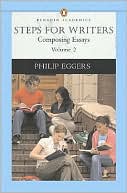Steps for Writers: Composing Essays, Volume 2
Search in google:
Every developing writer is different and has specific needs. Whether students lack confidence, are overconfident, or come to the course under prepared in grammar and process, writing their own event. By organizing Steps for College Writers around three phases of college writing–finding one’s own writing process, writing essays based on one’s own experience and perceptions, and writing essays involving texts and research, Phil Eggers aims to transform writing into an intrinsic experience for today’s developing writers. His graduated approach to grammar and writing teaches students the basic of composing solid paragraphs and essays by allowing students to mature in the process and build confidence. Grammar correctness and peer review are heavily emphasized, and student and professional models are incorporated throughout the text to show “real” writing.As part of the Penguin Academic Series, Steps for College Writers offers a compact, trade-format size and streamlined narrative to make this book both easy to handle and easy to read. Its brevity and low cost allows instructors to easily supplement the basic text with other books, including those on the list of Penguin titles offered at a deep discount as part of the Longman-Penguin Program.
Introduction: Visualizing the EssayStudent EssayStep One: Developing Your Own Thinking, Writing, and Learning Process 1. Prewriting Prewriting Experiments: Freewriting, Focused Writing, Brainstorming, Outlining, Clustering, CubingInteracting with Your ReadersIdentifying Your PurposePrewriting Activities: A Glimpse of a Student Writer at WorkWriting Tip #1Writing Exercises: Basic, Intermediate, ChallengeProofreading Practice: Identifying Sentence Divisions in Your PrewritingActivities: Basic, Intermediate, Challenge2. Making a PointThesis StatementsIntroductory ParagraphWriting Tip #2Writing Exercises: Basic, Intermediate, ChallengeProofreading Practice: Agreement of Subjects/Verbs: Basic, Int., Challenge3. Developing Your Body Paragraphs and Making ConclusionsExplaining and Illustrating Ideas in Your Body ParagraphsApplying Techniques of DevelopmentChoosing Modes of DevelopmentWriting Tip #3Writing Exercises: Basic, Intermediate, ChallengeConcluding ParagraphsProofreading Practice: Special Problems with Agreement: Basic, Intermediate, Challenge4. Global Revising: Doing an Extreme MakeoverMoving from Draft to Essay: A Glimpse of a Student Writer at WorkTesting Your Thesis: Looking for Digressions and Weak SpotsAchieving Continuity through TransitionsImproving Your Style: Breaking up, Varying and Combining SentencesInteracting with Your Reader (reading aloud to others)Peer Review QuestionsWriting Tip #4Writing Exercises: Basic, Intermediate, Challenge Proofreading Practice: Subordination: Basic, Intermediate, Challenge5. Putting on the Final TouchesImproving Word Choice; Eliminating WordinessProofreading Aloud; Locating Your Patterns of ErrorUsing Your Spelling and Grammar CheckWriting Tip #5Writing Exercises: Basic, Intermediate, ChallengeProofreading Practice: Spelling: Basic, Intermediate, Challenge:Step Two: Writing Essays Based on Your Own Experience and Perceptions6. Describing a Situation, Person, or Group Visualizing Your Subject and Giving It MeaningStudent EssayOrganizing a DescriptionExample by a Published Author: Using DetailsWriting Tip #6Writing Exercises:Basic, Intermediate, ChallengeEssay Topics: Descriptive WritingPeer Review QuestionsProofreading Practice: Adjectives & Adverbs: Basic, Intermediate, Challenge7. Telling a Story to Make a Point Organizing ChronologicallyTelling a Meaningful StoryStudent Essay: Telling a Story to Make a PointExample by a Published AuthorWriting Tip #7Writing Exercises:Basic, Intermediate, ChallengeEssay Topics: NarrationPeer Review QuestionsProofreading Practice: Past Tense: Basic, Intermediate, Challenge8. Enumerating ExamplesStudent EssayExample by a Published AuthorWriting Tip #8Writing Exercises: Basic, Intermediate, ChallengeEssay Topics: Illustrating with ExamplesPeer Review QuestionsProofreading Practice: Parallelism: Basic, Intermediate, Challenge9. Defining a TermStudent EssayExample by a Published AuthorExamples of Short DefinitionsLimiting the Scope of Your DefinitionExamining Your Subject from Different AnglesGiving Examples of the ConceptWriting Tip #10Writing Exercises: Basic, Intermediate, ChallengeEssay Topics: DefinitionPeer Review QuestionsProofreading Practice: Who and Which Clauses: Basic, Int., ChallengeStep Three: Writing Essays Based on Your Reading and Research10. Making a Comparison Comparing and Contrasting as a Way of KnowingTypes of ComparisonGathering Facts on Both SubjectsExploring Similarities and Differences: A Student Writer at WorkOrganizing Your MaterialStudent Essay: Exploring Similarities and DifferencesExample by a Published AuthorWriting Tip #9Writing Exercises: Basic, Intermediate, ChallengeEssay Topics: Comparison and ContrastPeer Review QuestionsProofreading Practice: Modifiers in Comparisons: Basic, Int., Challenge11. Explaining a Process or Procedure“How To” Writing: Giving Clear InstructionsStudent Essay: Explaining a ProcedureAnalyzing a Process: Making the ConnectionsResearching Facts on the ProcessExample by a Published Author: Analyzing a ProcessWriting Tip #11Writing Exercises: Basic, Intermediate, ChallengeEssay Topics: Procedural WritingPeer Review QuestionsProofreading Practice: Present and Progressive Tenses: Basic, Intermediate, Challenge12. Analyzing Cause and Effect Student Essay Example by a Published AuthorBeing Logical: Causes vs. CoincidencesIdentifying all the Causes and EffectsFinding the Necessary InformationWriting Tip #12Writing Exercises: Basic, Intermediate, ChallengeEssay Topics: Cause and EffectPeer Review QuestionsProofreading Practice: Compound and Complex Sentences13. Arguing Persuasively Student EssayExample by a Published AuthorGuidelines for Persuasive WritingStressing the Argument, Not the PersonalitiesApproaching the Argument from Several AnglesResearching and Presenting Supporting MaterialWriting Tip #13Writing Exercises: Basic, Intermediate, ChallengeEssay Topics: Arguing PersuasivelyPeer Review QuestionsProofreading Practice: Sentence Combining: Basic, Intermediate, Challenge14. Writing a Research Paper Making Sense with Sources Summarizing and ParaphrasingQuoting: the Long and Short of ItUsing the Library and InternetAnalyzing Source Material; Evaluating Web SitesAvoiding PlagiarismWriting a BibliographySample Short MLA paperWriting Tip #14Research Paper ChecklistWriting Exercises:Basic, Intermediate, ChallengeEssay Topics: Research PaperPeer Review QuestionsProofreading Practice: MLA Form: Basic, Intermediate, Challenge15. Writing about LiteratureMethods of Interpreting a Story, Play, or PoemStudent EssayExample by a Published AuthorAnalyzing vs. ParaphrasingDeveloping a Point by Using the TextWriting Tip #15Writing Exercises: Basic, Intermediate, ChallengeEssay Topics: Writing about LiteraturePeer Review QuestionsProofreading Practice: Quoting Correctly from Literary Works,Basic, Intermediate, ChallengeAppendix: Punctuation HandbookIndex of Grammar TopicsAdjectives and AdverbsAgreement of Subject and VerbComma SpliceCompound and Complex SentencesD EndingsFragmentsIrregular VerbsParallelismPast TensePresent and Progressive TensesPronoun CaseQuotingRun-on SentencesS EndingsSentence CombiningSentence DivisionsSpellingSubordinationWho and Which ClausesWordiness








